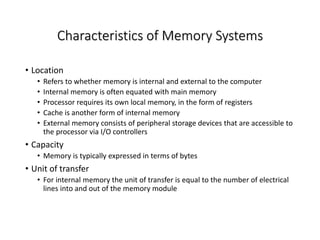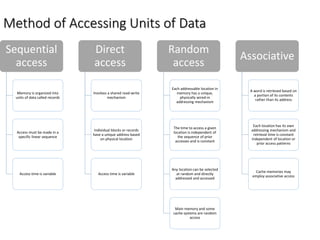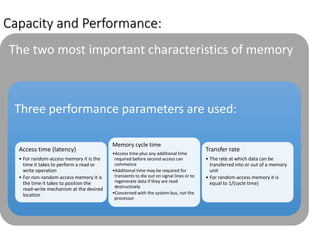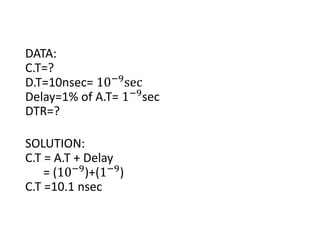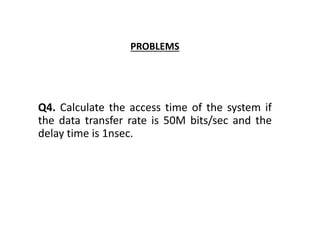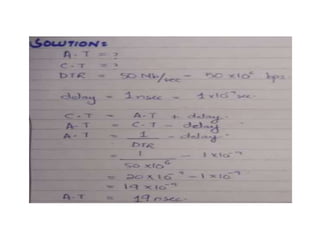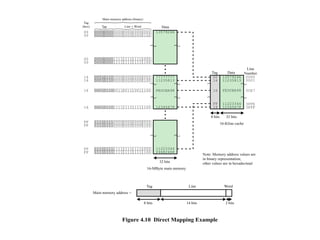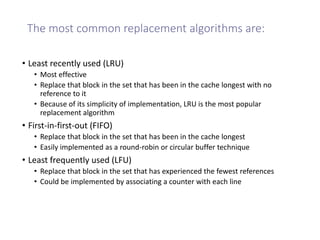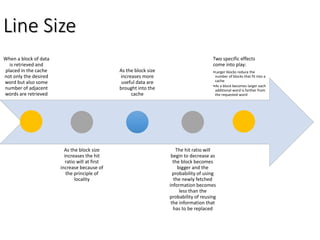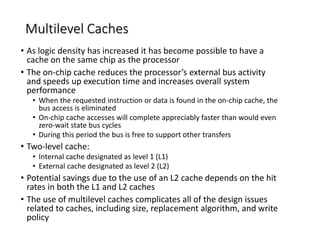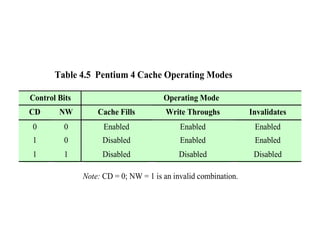cache cache memory memory cache memory.pptx
- 2. Table 4.1 Key Characteristics of Computer Memory Systems Location Internal (e.g. processor registers, cache, main memory) External (e.g. optical disks, magnetic disks, tapes) Capacity Number of words Number of bytes Unit of Transfer Word Block Access Method Sequential Direct Random Associative Performance Access time Cycle time Transfer rate Physical Type Semiconductor Magnetic Optical Magneto-optical Physical Characteristics Volatile/nonvolatile Erasable/nonerasable Organization Memory modules
- 3. Characteristics of Memory Systems • Location • Refers to whether memory is internal and external to the computer • Internal memory is often equated with main memory • Processor requires its own local memory, in the form of registers • Cache is another form of internal memory • External memory consists of peripheral storage devices that are accessible to the processor via I/O controllers • Capacity • Memory is typically expressed in terms of bytes • Unit of transfer • For internal memory the unit of transfer is equal to the number of electrical lines into and out of the memory module
- 4. Method of Accessing Units of Data Sequential access Memory is organized into units of data called records Access must be made in a specific linear sequence Access time is variable Direct access Involves a shared read-write mechanism Individual blocks or records have a unique address based on physical location Access time is variable Random access Each addressable location in memory has a unique, physically wired-in addressing mechanism The time to access a given location is independent of the sequence of prior accesses and is constant Any location can be selected at random and directly addressed and accessed Main memory and some cache systems are random access Associative A word is retrieved based on a portion of its contents rather than its address Each location has its own addressing mechanism and retrieval time is constant independent of location or prior access patterns Cache memories may employ associative access
- 5. Capacity and Performance: The two most important characteristics of memory Three performance parameters are used: Access time (latency) • For random-access memory it is the time it takes to perform a read or write operation • For non-random-access memory it is the time it takes to position the read-write mechanism at the desired location Memory cycle time •Access time plus any additional time required before second access can commence •Additional time may be required for transients to die out on signal lines or to regenerate data if they are read destructively •Concerned with the system bus, not the processor Transfer rate • The rate at which data can be transferred into or out of a memory unit • For random-access memory it is equal to 1/(cycle time)
- 6. PROBLEMS Q1. Calculate the cycle time of the system if the access time is 10msec and the delay time is 1% of the access time. Also calculate the data transfer rate.
- 7. DATA: C.T=? D.T=10nsec= 10−9 sec Delay=1% of A.T= 1−9 sec DTR=? SOLUTION: C.T = A.T + Delay = (10−9 )+(1−9 ) C.T =10.1 nsec
- 8. D.T.R = 1/C.T D.T.R = 1/10.1 nsec=0.099 nsec D.T.R= 0.0999 x 10−3 /10−3 D.T.R =99 10 6 D.T.R =99.0 Mbits/sec
- 9. PROBLEMS Q2. Calculate the cycle time of the system if the access time is 20nsec and the delay time is 2% of the access time. Also calculate the data transfer rate.
- 11. PROBLEMS Q3. Calculate the access time of the system if the data transfer rate is 100M bits/sec and the delay time is 2nsec.
- 13. PROBLEMS Q4. Calculate the access time of the system if the data transfer rate is 50M bits/sec and the delay time is 1nsec.
- 15. PROBLEMS Q5. In a system the address generated by CPU appears in the address register at 110nsec of the clock pulse. The data appears in the data register at 200nsec of the clock pulse. The delay of the system is 20nsec. Calculate access time, cycle time and DTR.
- 18. Memory • The most common forms are: • Semiconductor memory • Magnetic surface memory • Optical • Magneto-optical • Several physical characteristics of data storage are important: • Volatile memory • Information decays naturally or is lost when electrical power is switched off • Nonvolatile memory • Once recorded, information remains without deterioration until deliberately changed • No electrical power is needed to retain information • Magnetic-surface memories • Are nonvolatile • Semiconductor memory • May be either volatile or nonvolatile • Nonerasable memory • Cannot be altered, except by destroying the storage unit • Semiconductor memory of this type is known as read-only memory (ROM) • For random-access memory the organization is a key design issue • Organization refers to the physical arrangement of bits to form words
- 19. Memory Hierarchy • Design constraints on a computer’s memory can be summed up by three questions: • How much, how fast, how expensive • There is a trade-off among capacity, access time, and cost • Faster access time, greater cost per bit • Greater capacity, smaller cost per bit • Greater capacity, slower access time • The way out of the memory dilemma is not to rely on a single memory component or technology, but to employ a memory hierarchy
- 20. Figure 4.1 The Memory Hierarchy Inboard memory Outboard storage Off-line storage Main memory Magnetic disk CD-ROM CD-RW DVD-RW DVD-RAM Blu-Ray Magnetic tape Cache Reg- isters
- 21. 0 T1 T1 + T2 T2 1 Fraction of accesses involving only Level 1 (Hit ratio) Average access time Figure 4.2 Performance of a Simple Two-Level Memory
- 22. Memory • The use of three levels exploits the fact that semiconductor memory comes in a variety of types which differ in speed and cost • Data are stored more permanently on external mass storage devices • External, nonvolatile memory is also referred to as secondary memory or auxiliary memory • Disk cache • A portion of main memory can be used as a buffer to hold data temporarily that is to be read out to disk • A few large transfers of data can be used instead of many small transfers of data • Data can be retrieved rapidly from the software cache rather than slowly from the disk
- 23. CPU Word Transfer Fast Fastest Fast Less fast Slow Slow Block Transfer Cache Main Memory Figure 4.3 Cache and Main Memory (a) Single cache (b) Three-level cache organization CPU Level 1 (L1) cache Level 2 (L2) cache Level 3 (L3) cache Main Memory
- 24. Memory address 0 1 2 0 1 2 C – 1 3 2n – 1 Word Length Block Length (K Words) Block 0 (K words) Block M – 1 Line Number Tag Block (b) Main memory (a) Cache Figure 4.4 Cache/Main-Memory Structure
- 25. Receive address RA from CPU Is block containing RA in cache? Fetch RA word and deliver to CPU DONE Access main memory for block containing RA Allocate cache line for main memory block Deliver RA word to CPU Load main memory block into cache line Figure 4.5 Cache Read Operation START No Yes
- 26. Processor Cache Address Address buffer Data buffer Control Data Figure 4.6 Typical Cache Organization Control System Bus
- 27. Table 4.2 Elements of Cache Design Cache Addresses Logical Physical Cache Size Mapping Function Direct Associative Set Associative Replacement Algorithm Least recently used (LRU) First in first out (FIFO) Least frequently used (LFU) Random Write Policy Write through Write back Line Size Number of caches Single or two level Unified or split
- 28. Cache Addresses • Virtual memory • Facility that allows programs to address memory from a logical point of view, without regard to the amount of main memory physically available • When used, the address fields of machine instructions contain virtual addresses • For reads to and writes from main memory, a hardware memory management unit (MMU) translates each virtual address into a physical address in main memory Virtual Memory
- 29. Processor Main memory Cache Logical address Physical address Data MMU (a) Logical Cache Processor Main memory Cache Logical address Physical address Data MMU (b) Physical Cache Figure 4.7 Logical and Physical Caches
- 30. Table 4.3 Cache Sizes of Some Processors a Two values separated by a slash refer to instruction and data caches. b Both caches are instruction only; no data caches. (Table can be found on page 134 in the textbook.) Processor Type Year of Introduction L1 Cachea L2 cache L3 Cache IBM 360/85 Mainframe 1968 16 to 32 kB — — PDP-11/70 Minicomputer 1975 1 kB — — VAX 11/780 Minicomputer 1978 16 kB — — IBM 3033 Mainframe 1978 64 kB — — IBM 3090 Mainframe 1985 128 to 256 kB — — Intel 80486 PC 1989 8 kB — — Pentium PC 1993 8 kB/8 kB 256 to 512 KB — PowerPC 601 PC 1993 32 kB — — PowerPC 620 PC 1996 32 kB/32 kB — — PowerPC G4 PC/server 1999 32 kB/32 kB 256 KB to 1 MB 2 MB IBM S/390 G6 Mainframe 1999 256 kB 8 MB — Pentium 4 PC/server 2000 8 kB/8 kB 256 KB — IBM SP High-end server/ supercomputer 2000 64 kB/32 kB 8 MB — CRAY MTAb Supercomputer 2000 8 kB 2 MB — Itanium PC/server 2001 16 kB/16 kB 96 KB 4 MB Itanium 2 PC/server 2002 32 kB 256 KB 6 MB IBM POWER5 High-end server 2003 64 kB 1.9 MB 36 MB CRAY XD-1 Supercomputer 2004 64 kB/64 kB 1MB — IBM POWER6 PC/server 2007 64 kB/64 kB 4 MB 32 MB IBM z10 Mainframe 2008 64 kB/128 kB 3 MB 24-48 MB Intel Core i7 EE 990 Workstaton/ server 2011 6 ´ 32 kB/32 kB 1.5 MB 12 MB IBM zEnterprise 196 Mainframe/ Server 2011 24 ´ 64 kB/ 128 kB 24 ´ 1.5 MB 24 MB L3 192 MB L4
- 31. Mapping Function • Because there are fewer cache lines than main memory blocks, an algorithm is needed for mapping main memory blocks into cache lines • Three techniques can be used: Direct •The simplest technique •Maps each block of main memory into only one possible cache line Associative •Permits each main memory block to be loaded into any line of the cache •The cache control logic interprets a memory address simply as a Tag and a Word field •To determine whether a block is in the cache, the cache control logic must simultaneously examine every line’s Tag for a match Set Associative •A compromise that exhibits the strengths of both the direct and associative approaches while reducing their disadvantages
- 32. (a) Direct mapping First m blocks of main memory (equal to size of cache) b L0 Lm–1 L0 Lm–1 Bm–1 B0 b = length of block in bits t = length of tag in bits cache memory m lines b b t b t Figure 4.8 Mapping From Main Memory to Cache: Direct and Associative (b) Associative mapping one block of main memory cache memory
- 33. Word Line Tag WO W1 W2 W3 Compare 1 if match 0 if no match 0 if match 1 if no match W4j W(4j+1) W(4j+2) W(4j+3) Tag Data Cache L0 Li Memory Address (miss in cache) (hit in cache) w s–r w r s+w Main Memory Bj B0 s w Figure 4.9 Direct-Mapping Cache Organization Lm–1 s–r
- 34. 111111111111111111111100 111111111111111111111000 111111110000000000000000 000101101111111111111100 000101100011001110011100 111111110000000000000100 000101100000000000000100 000101100000000000000000 000000001111111111111100 000000000000000000000000 000000000000000000000100 000000001111111111111000 00 00 FF FF FF FF 16 16 16 16 00 00 13579246 Tag Tag (hex) Main memory address (binary) Tag Data 32 bits 16-Kline cache 8 bits 8 bits 2 bits Tag Main memory address = Figure 4.10 Direct Mapping Example Line Word Line Number Line + Word Data 77777777 11235813 12345678 FEDCBA98 FEDCBA98 24682468 11223344 13579246 00 16 FF 16 16 0000 0001 0CE7 3FFE 3FFF 11235813 FEDCBA98 11223344 12345678 14 bits 32 bits 16-MByte main memory Note: Memory address values are in binary representation; other values are in hexadecimal
- 35. Direct Mapping Summary • Address length = (s + w) bits • Number of addressable units = 2s+w words or bytes • Block size = line size = 2w words or bytes • Number of blocks in main memory = 2s+ w/2w = 2s • Number of lines in cache = m = 2r • Size of tag = (s – r) bits
- 36. PROBLEMS Q1. The size of the main memory is 16M bytes and the size of the cache memory is 65K bytes, the main memory block is 4 bytes. Calculate the no. of bits required for TAG field, SLOT field and Byte or WORD if the address generated by the CPU is (4096AF) specific the bit pattern of the above mentioned field using direct mapping function.
- 39. Victim Cache • Originally proposed as an approach to reduce the conflict misses of direct mapped caches without affecting its fast access time • Fully associative cache • Typical size is 4 to 16 cache lines • Residing between direct mapped L1 cache and the next level of memory
- 40. Tag Word W0 W1 W2 W3 L0 Compare W4j W(4j+1) W(4j+2) W(4j+3) Tag Data Cache Memory Address (miss in cache) (hit in cache) w w s s+w Main Memory B0 Bj s w Figure 4.11 Fully Associative Cache Organization Lm–1 Lj s 1 if match 0 if no match 0 if match 1 if no match
- 41. 111111111111111111111100 111111111111111111111000 111111111111111111110100 000101100011001110011000 000101100011001110011100 000101100011001110100000 000000000000000000000100 000000000000000000000000 13579246 FEDCBA98 Tag Data 32 bits 16 Kline Cache 22 bits Tag Main Memory Address = Figure 4.12 Associative Mapping Example Word Line Number Data FEDCBA98 24682468 11223344 33333333 11223344 3FFFFE 058CE7 000000 3FFFFF 0000 0001 3FFE 3FFF FEDCBA98 13579246 3FFFFD 3FFD 33333333 24682468 32 bits 16 MByte Main Memory 2 bits 22 bits 000000 000001 Tag (hex) 058CE7 058CE8 058CE6 3FFFFE 3FFFFD 3FFFFF Tag Main memory address (binary) Word Note: Memory address values are in binary representation; other values are in hexadecimal
- 42. Associative Mapping Summary • Address length = (s + w) bits • Number of addressable units = 2s+w words or bytes • Block size = line size = 2w words or bytes • Number of blocks in main memory = 2s+ w/2w = 2s • Number of lines in cache = undetermined • Size of tag = s bits
- 43. PROBLEMS Q2. The size of the main memory is 16M bytes and the size of the cache memory is 65K bytes, the main memory block is 4 bytes. Calculate the no. of bits required for TAG field and WORD if the address generated by the CPU is (4096AF) specific the bit pattern of the above mentioned field using Associative mapping function.
- 45. Set Associative Mapping • Compromise that exhibits the strengths of both the direct and associative approaches while reducing their disadvantages • Cache consists of a number of sets • Each set contains a number of lines • A given block maps to any line in a given set • e.g. 2 lines per set • 2 way associative mapping • A given block can be in one of 2 lines in only one set
- 46. Figure 4.13 Mapping From Main Memory to Cache: k-way Set Associative First v blocks of main memory (equal to number of sets) Cache memory - way 1 Cache memory - way k one set (b) k direct-mapped caches v lines Bv–1 B0 L0 Lv–1 (a) v associative-mapped caches First v blocks of main memory (equal to number of sets) Cache memory - set 0 Cache memory - set v–1 k lines Bv–1 B0 L0 Lk–1
- 47. Set Associative Mapping Summary • Address length = (s + w) bits • Number of addressable units = 2s+w words or bytes • Block size = line size = 2w words or bytes • Number of blocks in main memory = 2s+w/2w=2s • Number of lines in set = k • Number of sets = v = 2d • Number of lines in cache = m=kv = k * 2d • Size of cache = k * 2d+w words or bytes • Size of tag = (s – d) bits
- 48. 000101100111111111111100 111111111111111111111000 111111111000000000000000 000101100011001110011100 000101100000000000000000 000000001111111111111000 000000000000000000000000 13579246 000 000 000 000 Tag (hex) Tag Data 32 bits 16 Kline Cache 9 bits Tag Main Memory Address = Figure 4.15 Two-Way Set Associative Mapping Example Set Word Tag Data Set Number Data 77777777 11235813 12345678 FEDCBA98 FEDCBA98 24682468 11223344 02C 02C 02C 02C 1FF 1FF 1FF 1FF 77777777 13579246 000 02C 1FF 02C 02C 0000 0001 0CE7 1FFE 1FFF 02C 24682468 1FF 11235813 11223344 12345678 32 bits 16 MByte Main Memory 32 bits 9 bits FEDCBA98 2 bits 13 bits 9 bits 111111111111111111111100 111111111000000000000100 000101100000000000000100 000000001111111111111100 000000000000000000000100 Tag Main memory address (binary) Set + Word Note: Memory address values are in binary representation; other values are in hexadecimal
- 49. Figure 4.16 Varying Associativity over Cache Size 0.0 1k Hit ratio 2k 4k 8k 16k Cache size (bytes) direct 2-way 4-way 8-way 16-way 32k 64k 128k 256k 512k 1M 0.1 0.2 0.3 0.4 0.5 0.6 0.7 0.8 0.9 1.0
- 50. PROBLEMS Q3. The size of the main memory is 16M bytes and the size of the cache memory is 65K bytes, the main memory block is 4 bytes. Calculate the no. of bits required for TAG field, SLOT and WORD if the address generated by the CPU is (4096AF) specific the bit pattern of the above mentioned field using two (2) way set- associative mapping function.
- 53. PROBLEMS Q4. The size of the main memory is 16M bytes and the size of the cache memory is 65K bytes, the main memory block is 4 bytes. Calculate the no. of bits required for TAG field, SLOT and WORD if the address generated by the CPU is (4096AF) specific the bit pattern of the above mentioned field using 4 way set- associative mapping function.
- 56. Replacement Algorithms • Once the cache has been filled, when a new block is brought into the cache, one of the existing blocks must be replaced • For direct mapping there is only one possible line for any particular block and no choice is possible • For the associative and set-associative techniques a replacement algorithm is needed • To achieve high speed, an algorithm must be implemented in hardware
- 57. The most common replacement algorithms are: • Least recently used (LRU) • Most effective • Replace that block in the set that has been in the cache longest with no reference to it • Because of its simplicity of implementation, LRU is the most popular replacement algorithm • First-in-first-out (FIFO) • Replace that block in the set that has been in the cache longest • Easily implemented as a round-robin or circular buffer technique • Least frequently used (LFU) • Replace that block in the set that has experienced the fewest references • Could be implemented by associating a counter with each line
- 58. First-in-first-out (FIFO) Consider the following reference string: 0, 2, 1, 6, 4, 0, 1, 0, 3, 1, 2, 1. Using FIFO page replacement algorithm
- 59. When a block that is resident in the cache is to be replaced there are two cases to consider: If the old block in the cache has not been altered then it may be overwritten with a new block without first writing out the old block If at least one write operation has been performed on a word in that line of the cache then main memory must be updated by writing the line of cache out to the block of memory before bringing in the new block There are two problems to contend with: More than one device may have access to main memory A more complex problem occurs when multiple processors are attached to the same bus and each processor has its own local cache - if a word is altered in one cache it could conceivably invalidate a word in other caches Write Policy
- 60. Write Through and Write Back • Write through • Simplest technique • All write operations are made to main memory as well as to the cache • The main disadvantage of this technique is that it generates substantial memory traffic and may create a bottleneck • Write back • Minimizes memory writes • Updates are made only in the cache • Portions of main memory are invalid and hence accesses by I/O modules can be allowed only through the cache • This makes for complex circuitry and a potential bottleneck
- 61. Line Size When a block of data is retrieved and placed in the cache not only the desired word but also some number of adjacent words are retrieved As the block size increases the hit ratio will at first increase because of the principle of locality As the block size increases more useful data are brought into the cache The hit ratio will begin to decrease as the block becomes bigger and the probability of using the newly fetched information becomes less than the probability of reusing the information that has to be replaced Two specific effects come into play: •Larger blocks reduce the number of blocks that fit into a cache •As a block becomes larger each additional word is farther from the requested word
- 62. Multilevel Caches • As logic density has increased it has become possible to have a cache on the same chip as the processor • The on-chip cache reduces the processor’s external bus activity and speeds up execution time and increases overall system performance • When the requested instruction or data is found in the on-chip cache, the bus access is eliminated • On-chip cache accesses will complete appreciably faster than would even zero-wait state bus cycles • During this period the bus is free to support other transfers • Two-level cache: • Internal cache designated as level 1 (L1) • External cache designated as level 2 (L2) • Potential savings due to the use of an L2 cache depends on the hit rates in both the L1 and L2 caches • The use of multilevel caches complicates all of the design issues related to caches, including size, replacement algorithm, and write policy
- 63. 0.78 0.80 0.82 0.84 0.86 0.88 0.90 0.92 0.94 0.96 0.98 1k 2k 4k 8k 16k 32k L1 = 16k 64k 128k 256k 512k 1M 2M Hit ratio L2 Cache size (bytes) L1 = 8k Figure 4.17 Total Hit Ratio (L1 and L2) for 8 Kbyte and 16 Kbyte L1
- 64. Unified Versus Split Caches • Has become common to split cache: • One dedicated to instructions • One dedicated to data • Both exist at the same level, typically as two L1 caches • Advantages of unified cache: • Higher hit rate • Balances load of instruction and data fetches automatically • Only one cache needs to be designed and implemented • Trend is toward split caches at the L1 and unified caches for higher levels • Advantages of split cache: • Eliminates cache contention between instruction fetch/decode unit and execution unit • Important in pipelining
- 65. Problem Solution Processor on which Feature First Appears External memory slower than the system bus. Add external cache using faster memory technology. 386 Increased processor speed results in external bus becoming a bottleneck for cache access. Move external cache on- chip, operating at the same speed as the processor. 486 Internal cache is rather small, due to limited space on chip Add external L2 cache using faster technology than main memory 486 Contention occurs when both the Instruction Prefetcher and the Execution Unit simultaneously require access to the cache. In that case, the Prefetcher is stalled while the Execution Unit’s data access takes place. Create separate data and instruction caches. Pentium Create separate back-side bus that runs at higher speed than the main (front-side) external bus. The BSB is dedicated to the L2 cache. Pentium Pro Increased processor speed results in external bus becoming a bottleneck for L2 cache access. Move L2 cache on to the processor chip. Pentium II Add external L3 cache. Pentium III Some applications deal with massive databases and must have rapid access to large amounts of data. The on-chip caches are too small. Move L3 cache on-chip. Pentium 4 Table 4.4 Intel Cache Evolution
- 66. Figure 4.18 Pentium 4 Block Diagram Load address unit Integer register file L1 data cache (16 KB) FP register file Store address unit Simple integer ALU Instruction fetch/decode unit Out-of-order execution logic L2 cache (512 KB) L3 cache (1 MB) L1 instruction cache (12K mops) Simple integer ALU Complex integer ALU FP/ MMX unit FP move unit System Bus 64 bits 256 bits
- 67. Table 4.5 Pentium 4 Cache Operating Modes Control Bits Operating Mode CD NW Cache Fills Write Throughs Invalidates 0 0 Enabled Enabled Enabled 1 0 Disabled Enabled Enabled 1 1 Disabled Disabled Disabled Note: CD = 0; NW = 1 is an invalid combination.
- 68. Summary Chapter 4 • Computer memory system overview • Characteristics of Memory Systems • Memory Hierarchy • Cache memory principles • Pentium 4 cache organization Cache Memory • Elements of cache design • Cache addresses • Cache size • Mapping function • Replacement algorithms • Write policy • Line size • Number of caches


